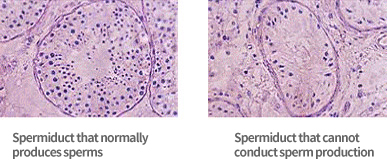IVF-Center
Diagnosis of subfertility
Diagnosis of male subfertility
Semen analysis
Subfertility couple should pass semen analysis first, because semen analysis is relatively convenient and it does not require female subfertility test. Normal outcome of semen analysis should have 2-5ml of semen, a number of semen over 15x106 ml/, semen motility over 50% and sperms in normal condition over 4% (standard of WHO 2010). When an abnormal outcome appears, conduct urological examination, hormone examination, spermiduct X-ray examination, testis tissue examination and immunologic test to establish the clear reason of male subfertility. Also detailed semen analysis can be used to check an accurate number and motility of sperms, and it has much more information than a normal analysis and be a great help to making pregnancy plan.
Hormone examination
Examination of pituitary and sex hormone such as FSH, LH, PRL, Testosterone should be conducted.
Examination of pituitary and sex hormone such as FSH, LH, PRL, Testosterone should be conducted.

Diagnosis of female subfertility
Ovulatory test
Ovulatory test is one of the most basic examinations for female subfertility. It executes basal body temperature table, cervical mucus test, hormone examination, ultrasound test and endometrium test to see whether the ovulation was conducted.
- Basal body temperature table
Observing the increase of cervical mucus when ovulating, or measuring female hormone or antibody hormone can show whether the ovulation was executed. Also if the changes of hormone that have a rise before the ovulation are understood through urine examination (LH hormone of urine), it is easy to assume the date of ovulation. - Cervical mucus and hormone test
By measuring and recording the basal temperature after getting up, doctors can check the existence of high temperature period in a period and fund whether the ovulation was executed. However there are lots of other good ways to diagnose ovulation currently, making basal temperature table is not the first recommended one. - Ovulation ultrasound test
Ovulation ultrasound test is to look through the growth of follicule containing ovum from the early stages to ovulation via ultrasound. When an exact date of ovulation is decided through ultrasound test, sexual relationship or artificial insemination inside uterus is executed to contribute to the rise of success rate of pregnancy. If it is a test-tube baby treatment, it helps decision of date of gathering ovum since it can help understand the degree of maturity of ovum with hormone test. It uses transvaginal ultrasound without pain, and through it, doctors can observe not only ovulation, but fibroid, malformation of uterus (damaged uterus, dihysteria), endometrial hyperplasia, endometriosis, ovarian tumor and other diseases simultaneously. - Endometrium examination
Ovulation can be indirectly observed by conducting tissue test of endometrium that changes by hormones from ovary depending on the periods.
Hormone examination
As hormones that are directly involved in the ovulation are pituitary hormone like FSH (follicle-stimulating hormone), LH (luteinizing hormone), and endocrinol metabolism hormones such as prolactin, TSH (thyrotrophin) with abnormality can be another reason of subfertility. Such examination are executed about 3 days after the beginning of period. Recently, more accurate methods of hormone examination which evaluate the function of AMH (Anti-mullerian hormone) or ovarian reserve are developed and utilized.
Immunologic examination
If antibodies against sperms are produced in the body, they exist in body fluid and interrupts the insemination of sperm and ovum. If a number and motility of sperms are normal, when they are positive with antisperm antibody showing high level of titier, the insemination can fail. Antibody test can be conducted directly in sperm during semen analysis or just a simple blood test.
Semen analysis after sex
It is a test that observes sperm motility via microscope in cervical mucus about 12 hours after a sex. It can see the abnormality of sperms or cervical mucus or subfertility caused by immunologic causes. However it is not an exact semen analysis or substitute for it.
Laparoscope diagnosis and examination
It is a test which observes inside of abdominal cavity via laparoscope directly with the naked eyes. If can be a help when a normal subfertility test failed to discover the causes of subfertility by finding endometriosis or adhesion in pelvic cavity. Also it can check if there is closure or adhesion of fallopian tubes and conjecture the success rate of pregnancy after fallopian tubes regeneration surgery.
- Indicant of laparoscopy
- When a closure or abnormality of fallopian tubes are found via X-ray HSG (hysterosalpingogram)
- When an adhesion of fallopian tubes is suspected or abnormal result is found in abdominal cavity through ultrasound examination
- When endometriosis or subfertility by unknown causes is suspected considering a history of patient
- How to conduct the treatment
Put a patient under general anesthesia, make a tiny cut near the navel and inflate the stomach with carbonic acid gas. Insert laparoscope to observe all the organs and decide whether the operation is required. This endoscopy does not require hospitalization.
Hysteroscopy
It is an endoscopy method conducted by inserting hysteroscope, a tiny endoscope about 3cm in diameter, into uterus through cervix and observe the inside of uterus with the naked eyes. During hysteroscopy, direct operation with hysteroscope is possible. 2-3 hours after the treatment, a patient can go home.
- Indicant of hysteroscopy
- Uterine malformation
- Adhesion inside uterus
- Tumor in uterine cavity
- Abnormality of endometrium
- When the subfertility from unknown cause is suspected
X-ray HSG for uterine fallopian tubes
It is a test which inserts a contract medium through cervix and penetrates uterus and fallopian tubes via X-ray. It can check whether the uterine adhesion, malformation, tumor in uterine cavity or closure of fallopian tubes are produced.

